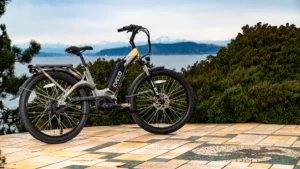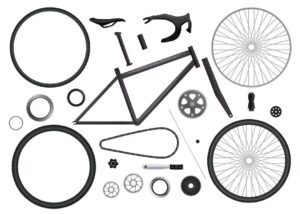Углеродное волокно – легкий, сильный, и прочный материал, состоящий из тонких нитей атомов углерода.. Он известен своей высокой прочностью на разрыв и малым весом., что делает его идеальным материалом для изготовления рам велосипедов.. Свойства углеродного волокна позволяют создавать жесткие и отзывчивые рамы, которые обеспечивают превосходную передачу мощности и характеристики управляемости.. В этой статье, мы рассмотрим различные типы углеродного волокна, используемого в велосипедных рамах., их характеристики, преимущества, и факторы, которые следует учитывать при выборе подходящего варианта для ваших велосипедных нужд.

Высокомодульное углеродное волокно
Высокомодульное углеродное волокно — самый жесткий и прочный тип углеродного волокна.. Он состоит из плотно упакованных углеродных волокон., в результате получается материал с исключительной жесткостью и минимальной гибкостью.. Термин “высокомодульный” относится к высокому уровню жесткости, присущим этому типу углеродного волокна., что позволяет ему передавать мощность и быстро эффективно реагировать на действия водителя.. Этот тип углеродного волокна обычно используется в высокопроизводительных дорожных и горных велосипедах, где жесткость и отзывчивость имеют решающее значение..
Характеристики
Высокомодульное углеродное волокно, известное как сверхвысокомодульное углеродное волокно, разработан для обеспечения исключительной жесткости и прочности при сохранении легкого профиля.. Он имеет низкое соотношение веса и прочности и высокую устойчивость к нагрузкам на изгиб и скручивание.. Он обеспечивает превосходную передачу энергии во время вращения педалей и обеспечивает максимальную выходную мощность, сводя к минимуму изгиб и вибрацию..
Преимущества конструкции рамы велосипеда
Высокомодульное углеродное волокно в рамах велосипедов повышает жесткость и отзывчивость., повышение эффективности рамы при передаче мощности водителя на колеса. Этот тип углеродного волокна улучшает общие характеристики велосипеда, обеспечивая превосходные возможности преодоления подъемов и лучшую управляемость на высоких скоростях.. Кроме, рамы, изготовленные из этого типа углеродного волокна, демонстрируют минимальные потери энергии при вращении педалей., позволяя велосипедистам достичь максимальной эффективности и скорости. Его точность прохождения поворотов и общая управляемость делают его идеальным для соревновательных гонок и езды, ориентированной на производительность..
Среднемодульное углеродное волокно
Углеродное волокно со средним модулем — это тип композитного материала, известный своим балансом между жесткостью и податливостью.. Он обеспечивает умеренный уровень жесткости, сохраняя при этом некоторую степень гашения вибраций., что обеспечивает комфортную и в то же время отзывчивую езду. Этот тип углеродного волокна обычно используется в шоссейных и универсальных велосипедах, где комфорт и производительность одинаково важны..
Характеристики
Углеродное волокно с промежуточным модулем известно своим умеренным соотношением веса и прочности и способностью гасить дорожные вибрации.. Он обеспечивает плавность и комфорт езды, сохраняя при этом достаточную жесткость для эффективной передачи мощности..
Применение в велосипедных рамах
Углеродное волокно со средним модулем обычно используется в рамах велосипедов, ориентированных на выносливость, предназначенных для езды на большие расстояния и пересеченной местности.. Например, одна из карбоновых рам премиум-класса Chinses TP-140018. Его способность поглощать дорожные вибрации повышает комфорт во время длительных поездок., снижение утомляемости и улучшение качества езды. Кроме того, рамы, изготовленные из углеродного волокна среднего модуля, обеспечивают сочетание эффективности и комфорта., что делает их подходящими для широкого спектра велосипедных дисциплин..
Стандартный модуль углеродного волокна
Стандартное углеродное волокно изготавливается из полиакрилонитрила. (КАСТРЮЛЯ) волокна-предшественники, которые карбонизуются при высоких температурах для создания чистых углеродных волокон.. Он обеспечивает хорошую жесткость, оставаясь при этом относительно доступным по сравнению с высокомодульными вариантами.. Благодаря своей доступности, он стал популярным выбором для многих производителей велосипедных рам.
Углеродное волокно стандартного модуля обычно используется в различных стилях велосипедных рам., от шоссейных велосипедов начального уровня до горных велосипедов высокого класса. Обеспечивает превосходную передачу мощности и отзывчивость., что делает его подходящим для велосипедистов-любителей и велосипедистов-энтузиастов, которым нужны рамы, ориентированные на производительность, без высокой цены..
Характеристики
Стандартное углеродное волокно отличается простотой производства и доступностью.. Оно обеспечивает достаточную жесткость для большинства гонщиков, но при этом более щадит с точки зрения качества езды по сравнению с высокомодульным углеродным волокном..
Распространенное использование в производстве велосипедных рам
Углеродное волокно стандартного модуля широко используется в шоссейных велосипедах начального уровня., пригородные велосипеды, и прогулочные горные велосипеды. Хоть и не такой жесткий, как высокомодульное углеродное волокно., Углеродное волокно стандартного модуля по-прежнему обеспечивает превосходную передачу мощности и отзывчивость.. Он обеспечивает хорошее сочетание производительности и доступности для велосипедистов, которым нужна легкая и прочная рама без больших затрат..
Преимущества различных типов углеродного волокна в велосипедных рамах

Каждый тип углеродного волокна, используемый в велосипедных рамах, предлагает уникальные преимущества, адаптированные к различным предпочтениям вождения и целям производительности.. Давайте рассмотрим преимущества высокомодульных, промежуточный модуль, и углеволокно стандартного модуля в конструкции рамы велосипеда..
Повышенная жесткость при скалолазании
Высокомодульное углеродное волокно повышает жесткость и жесткость рам велосипедов., делая их более отзывчивыми во время восхождений. Повышенная передача мощности и эффективность педалирования позволяют гонщикам преодолевать крутые подъемы с большей легкостью и скоростью..
Улучшенная амортизация
Углеродное волокно с промежуточным модулем обеспечивает улучшенные свойства поглощения ударов и вибрации., что обеспечивает более плавную и комфортную езду. Этот тип углеродного волокна помогает снизить усталость и дискомфорт во время длительных поездок по пересеченной местности или неровным поверхностям..
Улучшенная аэродинамика
Углеродное волокно со стандартным модулем обеспечивает хорошие аэродинамические свойства, которые помогают снизить сопротивление ветра и улучшить общую скорость.. Обтекаемая конструкция рам велосипедов, изготовленная из углеродного волокна стандартного модуля, обеспечивает эффективный поток воздуха и повышает производительность на соревнованиях по велоспорту..
Факторы, которые следует учитывать при выборе углеродного волокна для велосипедных рам
При покупке велосипедных рам из углеродного волокна от лучших китайских производителей углеродных рам, таких как СКОРО СИЯЙ, несколько факторов вступают в игру, чтобы обеспечить оптимальный опыт катания. Понимание этих ключевых соображений, например, вес, жесткость, и сила, имеет важное значение для принятия обоснованного решения.
Масса
Высокомодульное углеродное волокно — самый легкий вариант, идеально подходящий для гонщиков, которые отдают предпочтение характеристикам набора высоты и ускорению, но может стоить дороже., в то время как углеродное волокно стандартного модуля обеспечивает хороший баланс между весом и доступностью.. Однако, важно найти баланс между весом и долговечностью, поскольку чрезмерно легкие рамы могут пожертвовать прочностью и долговечностью..
Жесткость
Жесткость рамы из углеродного волокна напрямую влияет на передачу мощности и характеристики управляемости.. Рамы из высокомодульного углеродного волокна обеспечивают высочайший уровень жесткости., обеспечение отзывчивости и эффективности езды. Однако, гонщики, которые предпочитают более плавный, более послушные водители могут выбрать рамы, изготовленные из углеродного волокна среднего или стандартного модуля..
Сила
Хотя все типы углеродного волокна обладают исключительным соотношением прочности и веса., высокомодульное углеродное волокно обычно обеспечивает высочайший уровень прочности и ударопрочности.. Гонщики, которые придерживаются агрессивного стиля езды или участвуют в соревновательных гонках, могут извлечь выгоду из дополнительной долговечности рам из высокомодульного углеродного волокна.. В то время как углеродное волокно среднего и стандартного модуля обеспечивает достаточную прочность для большинства потребностей в велосипедном спорте для отдыха и соревнований..
Заключение
В заключение, Выбор углеродного волокна существенно влияет на характеристики и характеристики велосипедных рам.. Стремитесь ли к повышенной жесткости при подъемах?, превосходная амортизация для длительного комфорта, или улучшенная аэродинамика для спринта, различные типы углеродного волокна, используемые в велосипедных рамах, отвечают разнообразным требованиям.. Оценивая такие факторы, как вес, жесткость, и сила, велосипедисты могут выбрать идеальную раму из углеродного волокна, чтобы улучшить свои впечатления от езды..

















